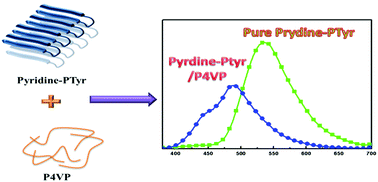Strong emission of 2,4,6-triphenylpyridine-functionalized polytyrosine and hydrogen-bonding interactions with poly(4-vinylpyridine)†
Abstract
In this paper 2,4,6-triphenyl pyridine-functionalized polytyrosine (Pyridine-PTyr) was successfully synthesized by living ring-opening polymerization where 2,6-bis(4-aminophenyl)-4-phenylpyridine (Pyridine-NH2) was the initiator. The photo-physical characteristics of Pyridine-NH2 and Pyridine-PTyr were elucidated via UV-vis absorption and photoluminescence spectra, revealing that unlike Pyridine-PTyr, Pyridine-NH2 shows solvatochromic effects in solvents with different polarities. Additionally, Pyridine-NH2 exhibited aggregation-caused quenching (ACQ) phenomena; however, it became an aggregation-induced emission (AIE) material after attachment to the rigid-rod conformation of polytyrosine. Based on differential scanning calorimetry results, we observed that after blending Pyridine-PTyr with P4VP a single glass transition temperature due to their miscibility through the intermolecular hydrogen bonding of the phenolic OH groups in the PTyr backbone and pyridine ring in P4VP was revealed, as indicated by IR spectroscopy. Obviously, the emission intensity of Pyridine-PTyr decreased after blending with P4VP with a hypsochromic shift from 536 to 489 nm, presumably due to the release of the restricted intramolecular rotation of the triphenyl pyridine unit in the center of the polymer and the polymer chains of Pyridine-PTyr became separated random coils based on WAXD results.


 Please wait while we load your content...
Please wait while we load your content...